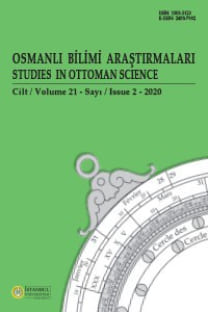Ziraat ve Sınaat Tercüme-i Fünun Odaları Mecmuası Üzerine Bir İnceleme
Tarım, Ziraat, Dergi, Süreli Yayın, Türkiye
A Turkish journal on agricultural sciences: Ziraat ve Sınaat Tercümei Fünun Odaları Mecmuası
Agriculture, Periodical, Turkey,
___
- -
- ISSN: 1303-3123
- Yayın Aralığı: Yılda 2 Sayı
- Başlangıç: 1995
- Yayıncı: İstanbul Üniversitesi Edebiyat Fakültesi
Türkiye Çocuk Hekimliğinin İlk Dergisi: La Pédiatrie en Turquie/Türkiye'de Emraz-ı Etfal
Zeynep Kamil Hastanesi'nin Kuruluşu ve Vakfiyesi
Şeref ETKER, Abdullah KÖŞE, Feza GÜNERGUN
Türkiye'de Botanik Tarihi Araştırmaları
Ziraat ve Sınaat Tercüme-i Fünun Odaları Mecmuası Üzerine Bir İnceleme
İstanbul Üniversitesi Edebiyat Fakültesi Bilim Tarihi Anabilim Dalı'nın Çalışmaları (2000-2003)
Türkiye Çocuk Hekimliğinin İlk Dergisi: La Pédiatrıe En Turquie / Türkiye'de Emraz-ı Etfal
Zeynep-Kamil Hastanesi'nin Kuruluşu ve Vakfiyesi
Şeref ETKER, Feza GÜNERGÜN, Abdullah KÖŞE
İSTANBUL ÜNİVERSİTESİ EDEBİYAT FAKÜLTESİ BİLİM TARİHİ ANABİLİM DALI’NIN ÇALIŞMALARI (20002003)
İstanbul Üniversitesi Edebiyat Fakültesi Bilim Tarihi Anabilim Dalı'nın Çalışmaları (2000-2003)
